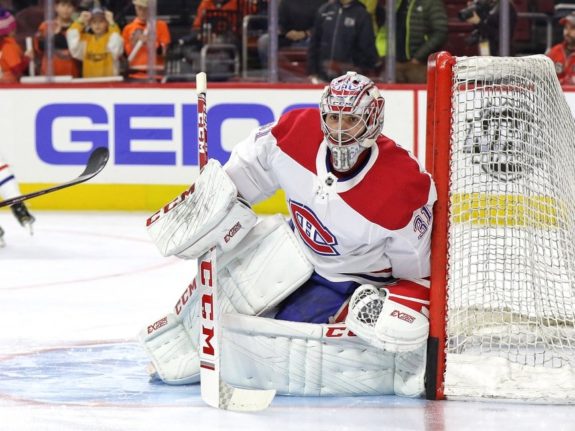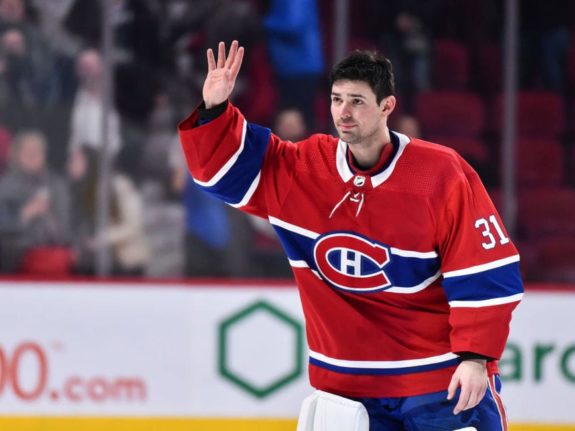Since his magical playoff run with the Montreal Canadiens in 2021, superstar goaltender Carey Price has been dealing with hip and knee injuries. He missed all but five games last season, recovering from those injuries and dealing with issues in his knee after each game he played. With four years left on his contract at $10.5 million per season, many fans would like to see the Habs shed that deal to free up much-needed cap space, either by trade, buyout or asking him to retire. This may sound easy, but it’s much more complicated.
Buying Out Price is the Worst Option
Price has four years left on his contract and will be 35 before this season starts; with his contract and all his health issues, trading him might seem like the worst scenario. Even though he is considered one of the best goaltenders in hockey, his recent issues could scare teams away from trying to acquire him. So, what is another way to get rid of a contract of an aging player? You could buy him out, as the Canadiens did with Karl Alzner.
According to the NHL’s buyout process, Montreal would have to do the following: Price is over the age of 26, so they will need to pay 2/3 of the remaining contract value, and the buyout would be spread over twice the length of the remainder of the contract. Multiply his remaining salary – excluding signing bonuses – by the amount determined by his age to get the buyout cost. Determine the savings by subtracting the annual buyout cost from step two by the player’s salary – excluding signing bonuses. Determine the remaining cap hit by removing the savings from step three from the player’s Annual Average Salary (AAV) – including signing bonuses.

In Price’s case, he would also need to clear waivers, which, because of his no-movement clause (NMC), he could waive and go straight to the buyout process if he wanted. If the Canadiens want to go this route, they have to consider his remaining contract, specifically the bonuses. He is set to receive $6.7 million this season, $6.5 million next season and $5.5 million in his final two seasons of signing bonus money alone. Therefore, the Canadiens would only save $2.3 million over eight seasons. Here is a breakdown of his buyout from CapFriendly:
| SEASON | INITIAL BASE SALARY | INITIAL CAP HIT | SIGNING BONUS | BUYOUT COST | POST-BUYOUT EARNINGS | SAVINGS | CAP HIT ( MTL) MTL) |
| 2022-23 | $1,000,000 | $10,500,000 | $6,750,000 | $583,333 | $7,333,333 | $416,667 | $10,083,333 |
| 2023-24 | $2,000,000 | $10,500,000 | $6,500,000 | $583,333 | $7,083,333 | $1,416,667 | $9,083,333 |
| 2024-25 | $2,000,000 | $10,500,000 | $5,500,000 | $583,333 | $6,083,333 | $1,416,667 | $9,083,333 |
| 2025-26 | $2,000,000 | $10,500,000 | $5,500,000 | $583,333 | $6,083,333 | $1,416,667 | $9,083,333 |
| 2026-27 | $0 | $0 | $0 | $583,333 | $583,333 | -$583,333 | $583,333 |
| 2027-28 | $0 | $0 | $0 | $583,333 | $583,333 | -$583,333 | $583,333 |
| 2028-29 | $0 | $0 | $0 | $583,333 | $583,333 | -$583,333 | $583,333 |
| 2029-30 | $0 | $0 | $0 | $583,333 | $583,333 | -$583,333 | $583,333 |
| TOTAL | $7,000,000 | $42,000,000 | $24,250,000 | $4,666,667 | $28,916,667 | $2,333,333 | $39,666,664 |
As we can see, buying out Price isn’t worth the hassle and doesn’t save the Canadiens any money over the eight seasons. They will pay out more over that time than any money saved and still have almost his entire cap hit for the first four seasons and negative savings for the final four seasons.
Trading Price is Complicated
Even at 35, a healthy Price could help any contending team win a Stanley Cup; an injured Price almost helped a Canadiens team that was nowhere near contending reach the Final in 2021. However, the most significant issues with moving him are his health and his cap hit.
There is no official word on whether he will be ready to start the season, but his former goaltending coach, Stephane Waite, seems to think he will. If he is healthy, the second big issue is that few teams can afford his contract. Only four teams in the NHL right now have enough cap space to take his entire cap hit, and only nine can afford it even if the Habs eat 50% of his cap hit. Montreal could even go as high as retaining 80%, and only three more teams can afford him, which wouldn’t help the Canadiens’ cap issues at all.
Related: Canadiens Should Consider Trading Allen to The Golden Knights
Yes, several teams are looking for a goaltender: the Vegas Golden Knights, Dallas Stars, and Arizona Coyotes are the top three rumoured to be knocking on doors. The Coyotes could take on Price’s entire salary and still have almost $10 million left in cap space. However, the Stars would have to work out a deal where the Canadiens would retain some of Price’s salary, and the Golden Knights are $5 million over the cap and nowhere close to taking on any of that contract. So that leaves Dallas and Arizona as viable options, but there is another wrinkle in any trade involving Price – his NMC. Price has a full say on where he gets traded, and if the Habs want to move him to Arizona, he would have to approve it.
Price is unlikely to green light a trade to a team that will finish in the league basement for the next couple of seasons, otherwise, he might as well stay in Montreal. The Stars looking more for a player to complement Jake Oettinger, who is not yet signed and may hold out for the start of the season. A deal could work if the Habs retain a portion of the contract, but again would Price want to play in Dallas? Ultimately, any trade involving Price will have to be approved by him.
Price’s Health is the Biggest Obstacle
Right now, everything hinges on Price’s health and whether or not he can play this season. At the end of last season, he was adamant that he still wanted to play. However, he also treated his final game like it could be the last of his career. Knee and hip injuries are challenging for any hockey player, but especially for a goalie’s range of movement. No competent general manager (GM) will want to trade for an aging, often injured goaltender, no matter his pedigree, unless they were 100% sure he was healthy and good to go.

Given the Canadiens’ cap issues, Price would be the best asset to trade to clear up their mess. Even at 50% retention, the team would still free up over $5 million in space, giving them enough to sign their remaining restricted free agents and open them up to over $20 million in cap space in 2023-24. This would only happen if a team wanted to trade for Price and Price is willing to accept.
If he isn’t healthy and can’t play, Montreal could take advantage of the long-term injury (LTIR) cap relief and use his $10.5 million. If he is done for his career, there is too much money on the table for him to retire, so over time, like they did with Shea Weber, they could move his contract to a team that needs the money to reach the cap floor or to use the LTIR.
It is easy to say, “just trade Price” or “buy him out and get rid of the contract,” but it’s not an easy process. He holds all the cards in any trade. Odds are he won’t win a Cup in Montreal, so he doesn’t need to stay, but if he’s going to be moved, he will want to go where he has a chance to win, and none of those teams can afford him. Buying him out would just be a poor move by management because it would cost them more to do it and the savings for the first four years are not worth it.
It’s not that Price can’t be moved. If Roberto Luongo and his albatross of a contract can be moved, so can Price and his contract. However, it’s easier said than done and probably not worth it in the end for the Canadiens; his contract only takes up eight percent of Montreal’s cap. In fact, his contract isn’t as much of a problem as the many expensive contracts of several bottom-six players. If anything, Hughes should be getting rid of those contracts and not Price’s.
